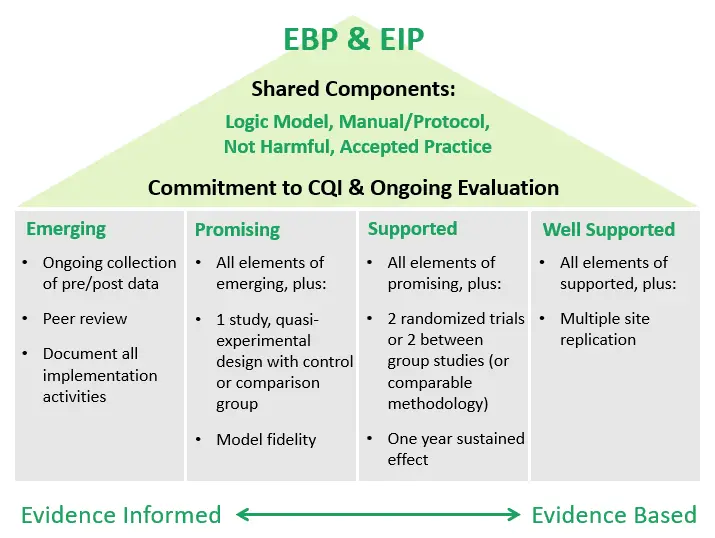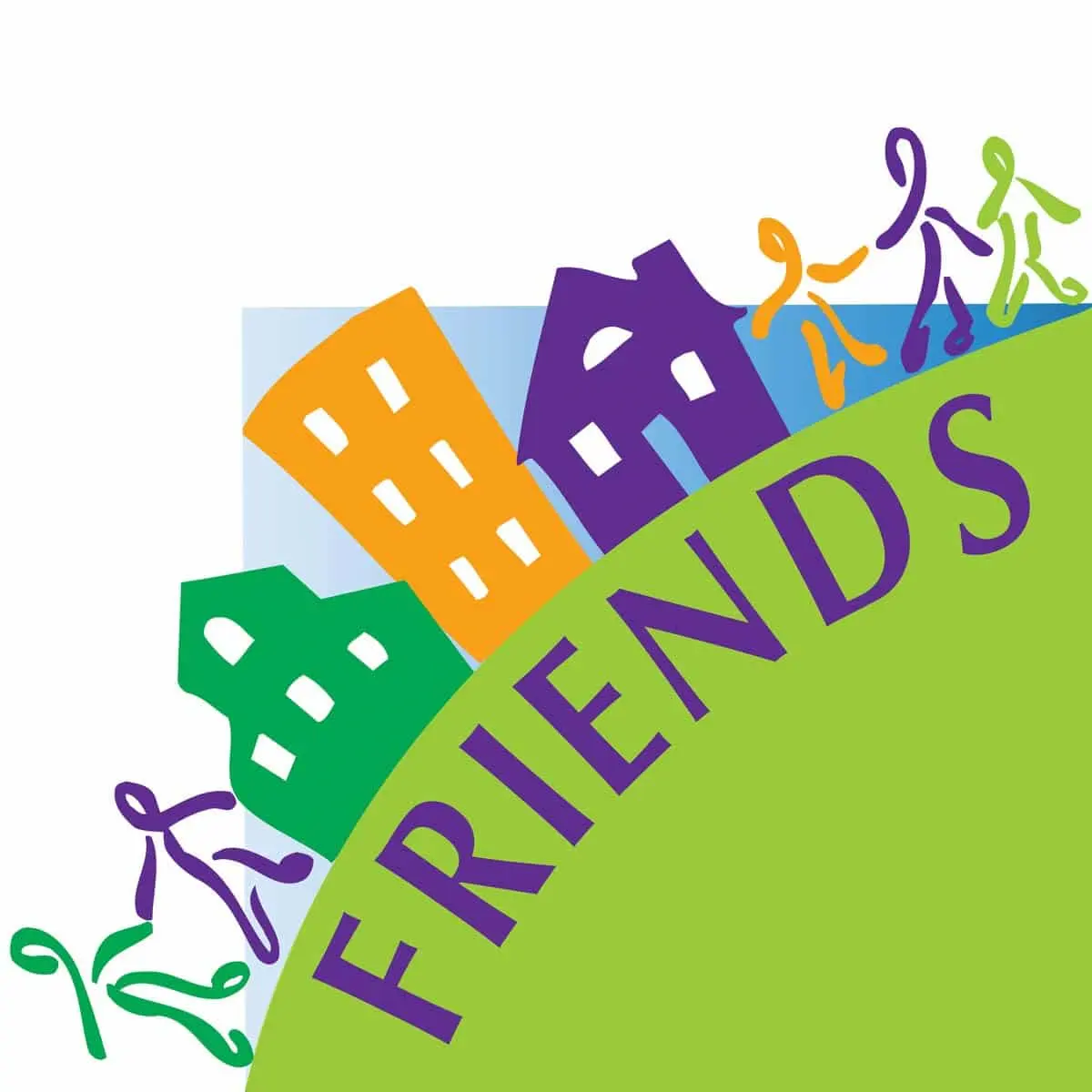Evidence-Based Practice in CBCAP
What are the evidence-based programs and practices?
Programs and practices recognized as evidence-based have demonstrated the highest level of evidence of effectiveness based on a set of evaluation or research criteria. These programs or practices, if implemented with adherence to the developer’s model, are likely to produce similar positive outcomes demonstrated in the evidence. In the most general terms, evidence-based programs and practices can be defined as the use of research to improve practice. However, what is meant by “research,” “practice,” and even “improve” may look very different in different contexts. It can be difficult for funders and programs to sort through various wording and determine what programming will be most effective for their needs and desired outcomes. FRIENDS tools and resources provided here are intended to assist in the understanding and selection of evidence-based programs and practices for CBCAP.
How does evidence-INFORMED practice differ from evidence-BASED practice?
Evidence-informed practice is similar to evidence-based, but the level of evidence supporting the programs or practices is not as strong. Evidence-informed practices may be considered “promising” or “emerging,” depending on the strength of the existing research or documentation of its evidence. (See the graphic below.) Evidence-informed practice allows for innovation within CBCAP, while still incorporating lessons learned from the existing research literature.

The above graphic of the “EB House” helps to illustrate the goals for programming in CBCAP. It is hoped that all funded programs will “reside in the house,” meaning they will rest somewhere on the continuum of EI to EB practice while meeting some basic standards. Every funded program should:
- Be based on a logic model
- Have a written manual or protocol
- Be generally accepted
- Shown to do no harm
- Demonstrate a commitment to ongoing evaluation and the establishment of a process for continuous quality improvement
An EB/EI program is a set of practices or a curriculum that is bundled together as a whole. This program is intended to be implemented with fidelity or with all of its pieces or “core components” in place to achieve the program’s intended outcomes. Nurse Family Partnership and Triple P – Positive Parenting Program System are examples of EB/EI programs, which require the implementation and administration of all program requirements for the program to achieve outcomes effectively.
EB/EI practices differ from EB/EI programs in that they are individualized interventions, assessments, services, or resources that can be implemented on their own. These can be thought of as “a la carte” options because they can be applied in isolation or grouped with other practices. Home visitation or parent education are examples of EB/EI practices where providers can adapt specific practice components of an evidence-based program or model to meet the needs of their community when determining which services to deliver.
CBCAP Lead Agencies should be mindful, however, that any revisions or alterations to programs or practices may impact their effectiveness. Thus, CBCAP Lead Agencies should always evaluate their practices and programs to see whether they are achieving the expected results for their identified target populations.
Each year, CBCAP Lead Agencies submit a detailed report on the funds spent on programs meeting the criteria used to define evidence‐based and evidence‐informed programs and practices. The CBCAP Program Instruction says,
“Provide evaluation data on the outcomes of programs and activities funded under this program, which should include the following:
A. Data reporting requirements and the national outcomes for the CBCAP program, as appropriate.
i. For the efficiency measure, provide data on the percentage of total funding that supports evidence-based and evidence-informed programs and practices;”
(Administration for Children and Families, 2022 Program Instruction, Part II, H, 8, pg. 25).
Evidence is defined in many ways. When we think about evidence-based decision-making, evidence is defined as information or facts that are systematically obtained (i.e., obtained in a manner that is replicable, observable, credible and verifiable) for use in making judgments or decisions (adapted from Rycroft-Malone et al., 2004 & Brownson et al., 2009). This definition of evidence applies to the best available research evidence as well as contextual and experiential evidence.
The best available research evidence is information that enables researchers, practitioners, and policy-makers to determine whether a prevention program, practice, or policy is achieving its intended outcomes. The best available research evidence can also help to determine whether a prevention strategy is harmful. The more rigorous a study (e.g., true/quasi-experimental design, independent replication), the more compelling the research evidence is indicating whether a program, practice, or policy is effectively preventing violence. The extent to which a prevention strategy has been replicated in multiple applied settings with diverse populations (external/ecological validity), and the availability and accessibility of implementation supports (implementation guidance) are also important aspects of best available research evidence.
Registries and clearinghouses of evidence-based programs are the best place to start when looking to find programs based on the best available research evidence. There are many registries available, but FRIENDS has compiled a list of some that are user-friendly and display information relevant to the prevention community. To learn about what they do, and to get the most current information, go directly to the registries websites:
- The California Evidence-Based Clearinghouse (CEBC) for Child Welfare
The mission of the California Evidence-Based Clearinghouse for Child Welfare (CEBC) is to advance the effective implementation of evidence-based practices for children and families involved with the child welfare system. - Title IV-E Prevention Services Clearinghouse – FFPSA
Title IV-E Prevention Services Clearinghouse was established by the Administration for Children and Families (ACF) to conduct an objective and transparent review of programs and services intended to provide enhanced support to children and families and prevent foster care placements. - Home Visiting Evidence of Effectiveness
The goal of Homvee has been to conduct a thorough and transparent review of the home visiting research literature to identify and evaluate evidence-based models that have proven effective. - Blueprints for Healthy Youth Development
Blueprints for Healthy Youth Development helps you quickly identify evidence-based programs that help young people reach their full potential. - Results First Clearinghouse Database
The Results First Clearinghouse Database is an online resource that brings together information on the effectiveness of social policy programs from nine national clearinghouses. - Social Programs That Work
Social Programs that Work seeks to identify social programs shown in rigorous studies to produce sizable, sustained benefits to participants and society, so that they can be deployed to help solve social problems.
The FRIENDS Crosswalk of Evidence-Based Programs provides the evidence ratings of relevant child abuse and neglect prevention programs from these six nationally recognized registries/clearinghouses and the CBCAP levels of evidence that can be used in the annual CBCAP report.
CBCAP State Leads are encouraged to explore and consider implementing EI/EB programs and practices that have been shown to effectively address the unmet needs of their population based on the outcomes of their needs assessments. States should review their existing continuum of prevention efforts and identify strategies to serve families along the continuum.
The selection of program services should be based on many factors, such as appropriateness for the population served, community needs, and agency capacity to implement services with fidelity. States should also consider their CBCAP funds allocation, as well as available funds to leverage when selecting an EI/EB program or practice.
The following resources may be helpful in selecting an evidence-based program.
- The California Evidence-Based Clearinghouse has a guide to selecting and implementing an EBP.
For more information on CBCAP requirements, see the section on CBCAP Standards above or contact your FRIENDS TA Coordinator.
Where can I learn more?
In addition, FRIENDS offers free on-line training in Evidence-Based Practice and different areas of Evaluation. Visit our Online Learning Center for more information and to enroll in the courses.
If you are a CBCAP Lead and require assistance in this area, contact your TA coordinator for help.
